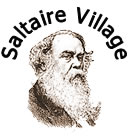|
Mawson Street, Saltaire
< Previous | Next >
The only individuals who were members of neither the Royal Family nor Titus Salt’s own family and who had Saltaire streets named in their honour were the architects Lockwood and Mawson. Born in Leeds in 1828, William Mawson was the son of a paper manufacturer of the same name. He was the younger partner of the architectural practice, being a mere 21 year old when the great building project that became Saltaire was started. For a quarter of a century from 1850 the two architects were the pre-eminent building designers in both Saltaire and Bradford. Some of their great achievements are given in our account of Lockwood St; others include St. Lukes Hospital (1852); Lumb Lane Mills (1861); the Eye and Ear Hospital (1861); and Horton Lane Congregational Chapel (1863). It was a time when Yorkshire Congregationalists were undertaking several ambitious church-building projects, and Lockwood and Mawson were also responsible for the design and construction of Congregational churches in Harrogate, Lightcliffe and Scarborough.
With the death of Lockwood in 1878, the firm was renamed W. and R. Mawson, with Richard Mawson (1834-1904) becoming the second partner. The 1881 census records William Mawson, a bachelor, living at 3, Clifton Villas, Manningham. He died on 25th April, 1889, aged 61, and was buried in Undercliffe Cemetery. His imposing grave can be seen on the Cemetery’s main terrace, a little distance from those of several civic leaders of Bradford, with whom he and Lockwood had been so closely associated.
© Barlo & Shaw
|

